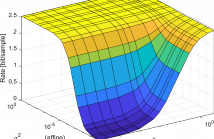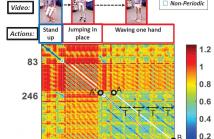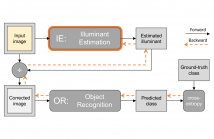
- Read more about Rate-Distortion Theory for Affine Global Motion Compensation in Video Coding
- Log in to post comments
In this work, we derive the rate-distortion function for video coding using affine global motion compensation.
We model the displacement estimation error during motion estimation and obtain the bit rate after applying the rate-distortion theory.
We assume that the displacement estimation error is caused by a perturbed affine transformation.
The 6 affine transformation parameters are assumed statistically independent, with each of them having a zero-mean Gaussian distributed estimation error.
- Categories:
 14 Views
14 Views
- Read more about Image fusion of X-ray and electron tomograms
- Log in to post comments
ICIP-Yan.pdf
- Categories:
 7 Views
7 Views
- Read more about OBJECTNESS-AWARE TRACKING VIA DOUBLE-LAYER MODEL
- Log in to post comments
The prediction drifts to the non-object backgrounds is a critical issue in conversional correlation filter (CF) based trackers. The key insight of this paper is to propose a doublelayer model to address this problem. Specifically, the first layer is a CF tracker, which is employed to predict a rough position of the target, and the objectness layer, which is regarded as the second layer, is utilized to reveal the object characteristics of the predicted target.
- Categories:
 12 Views
12 Views
- Read more about Real-time Hyperspectral Stereo Processing for the Generation of 3D Depth Information
- Log in to post comments
- Categories:
 39 Views
39 Views
We present a solution to the problem of discovering all periodic
segments of a video and of estimating their period in
a completely unsupervised manner. These segments may be
located anywhere in the video, may differ in duration, speed,
period and may represent unseen motion patterns of any type
of objects (e.g., humans, animals, machines, etc). The proposed
method capitalizes on earlier research on the problem
of detecting common actions in videos, also known as commonality
detection or video co-segmentation. The proposed
- Categories:
 26 Views
26 Views
- Read more about Markerless Closed-Loop Projection Plane Tracking for Mobile Projector-Camera Systems
- Log in to post comments
The recent trend towards miniaturization of mobile projectors is allowing new forms of information presentation and interaction. Projectors can easily be moved freely in space either by humans or by mobile robots. This paper presents a technique to dynamically track the orientation and position of the projection plane only by analyzing the distortion of the projection by itself, independent of the presented content. It allows distortion-free projection with a fixed metric size for moving projector-camera systems.
- Categories:
 9 Views
9 Views
- Read more about A deep neural network for oil spill semantic segmentation in SAR images
- Log in to post comments
Oil spills pose a major threat of the oceanic and coastal environments, hence, an automatic detection and a continuous monitoring system comprises an appealing option for minimizing the response time of relevant operations. Numerous efforts have been conducted towards such solutions by exploiting a variety of sensing systems such as satellite Synthetic Aperture Radar (SAR) which can identify oil spills over sea surfaces in any environmental conditions and operational time. Such approaches include the use of artificial neural networks which effectively identify the polluted areas.
- Categories:
 53 Views
53 Views
In this paper we present a deep learning method to estimate the illuminant of an image. Our model is not trained with illuminant annotations, but with the objective of improving performance on an auxiliary task such as object recognition. To the best of our knowledge, this is the first example of a deep learning architecture for illuminant estimation that is trained without ground truth illuminants. We evaluate our solution on standard datasets for color constancy, and compare it with state of the art methods.
- Categories:
 6 Views
6 Views
This paper proposes a novel approach for colorizing near infrared (NIR) images using a S-shape network (SNet). The proposed approach is based on the usage of an encoder-decoder architecture followed with a secondary assistant network. The encoder-decoder consists of a contracting path to capture context and a symmetric expanding path that enables precise localization. The assistant network is a shallow
- Categories:
 41 Views
41 Views
- Read more about DEPTH ESTIMATION NETWORK FOR DUAL DEFOCUSED IMAGES WITH DIFFERENT DEPTH-OF-FIELD
- Log in to post comments
In this work, we propose an algorithm to estimate the depth map of a scene using defocused images. In particular, the depth map is estimated using two defocused images with different depth-of-field for the same scene. Similar to the approach of the general depth from defocus (DFD), the proposed algorithm obtains the depth information from the
- Categories:
 45 Views
45 Views